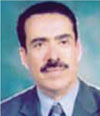
Interview with Jamal M. A. Sholan for the Yemen Times”Remember one thing: it is the buildings that kill people, not the earthquake!” [Archives:2006/982/Health]
September 18 2006
 |
 |
 |
Could you tell us about the seismological observatory center?
We started our activities through the installation of seismological stations and geological investigations for seismic hazard after Dhamar Earthquake Disaster in December 13, 1982. At that time no one had a clear idea about what a seismic hazard is, or the probability of earthquakes occurrences in Yemen. Today the center has more than fifty four employees including engineers, technicians and seismologists, as well as administrative staff.
Triggered by the Dhamar earthquake disaster and the excellent response of Yemeni government (especially appreciated, the response of the president Ali Abdullah Salih) as well as Arab and friends, the Program for Assessment and Mitigation of Earthquake Risk in Arab Region (PAMERAR) was conducted by the Arab Fund for Economic and Social Development (Kuwait). This was the starting step in founding seismic work in Yemen, through training and seismic network instruments supporting, of course with local financing to operate these seismic networks.
At that time, the roles and responsibilities of the different ministries and authorities were defined, in association with governorate of Dhamar and mandated group in the supreme council of reconstruction in Dhamar province. This could be considered as the foundation rock of seismology and seismic networking in Yemen, naturally because this step was a big technical and scientific challenge for our country. However, the actual steps of seismic networks installation were not achieved until 1989 when the financial approval and approval for Yemen/PAMERAR project were issued.
After unification in 1990 the center worked on covering whole of the country and this required reestablishing the network. And now with the support of the Supreme Council of Reconstruction in Dhamar which hosts the center, and assistance from officers in the ministry of oil and minerals and geological survey board the NSOC is operating well.
All of us at the NSO Center are grateful to our colleagues and officers at the Geological Survey Board and the Ministry of Oil for their continuous support.
The Center operates through three seismic networks:
– Twelve digital seismic stations distributed in different parts of Yemen connected to central workstation in Dhamar by telephone lines.
– Fifteen strong motion stations also distributed in some selected sites or main buildings in major cities.
– Three telemetry stations observed local activity in the central portion of Yemen.
– Number of portable seismic stations used for filed and aftershocks activities.
Working in the seismic field requires a great deal of patience as we work around the clock 24 hours seven. Perhaps this is one of the factors why not many people want to join this field.
Is Yemen a prone country to earthquakes?
Referring to the data collected from International Seismological Center in London and also from different professional sources and published papers. If you refer to (figure.1) you will see the seismological history through 100 years (upper picture) and through the 10 years (lower picture) earthquakes locations recognized by international seismic stations. I would like to mention here that one of our staff obtained his PhD in historical Seismicity under the Yemen- PAMERAR project.
The second figure (fig.2) indicates the earthquakes history through the past 1000 years in the region, which was reported by famous historical Seismicity Prof. called Ambraseys, N. N.
All the highlighted areas in the maps especially the most recent one which indicates the history of earthquakes in 10 years, provide indicators of probability occurrence of earthquakes. What is alarming, however, is that through reviewing the population areas figured in demographics map (figure 3), it is obvious that the population is concentrated on the most prone areas to earthquakes, and we can guess the scale of hazard during the next probable damaging earthquake.
That is really interesting, so what does this reflect on the buildings and construction in our country?
The importance of this Center lies in the fact that we represent the technical source for seismic information, files, annual seismic bulletins etc in Yemen. Producing this information and providing consultation are basic parts of our work. For instance, we established what we call the \”seismic code for construction\”” which is criteria through which an establishment is said to be resistant to earthquakes or not.
It is our field of specialization and it is our responsibility to inform the authorities of the minimum standards that must be ensured when constructing a new building. Through our work and field research we realized that the majority of constructions


